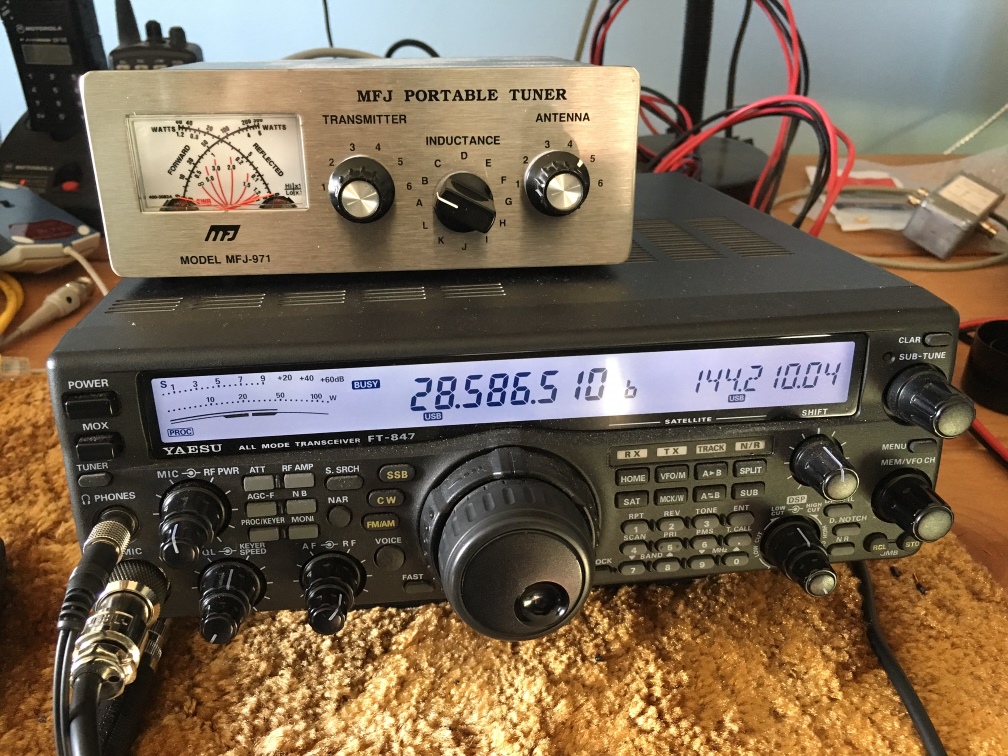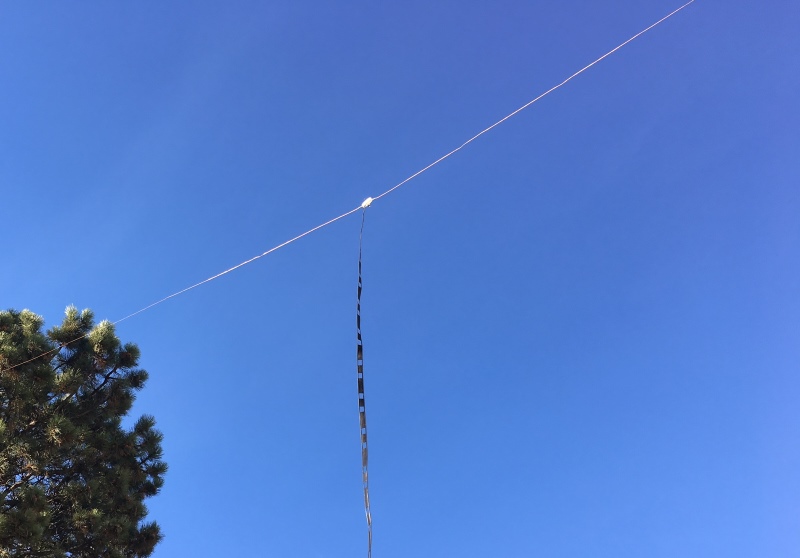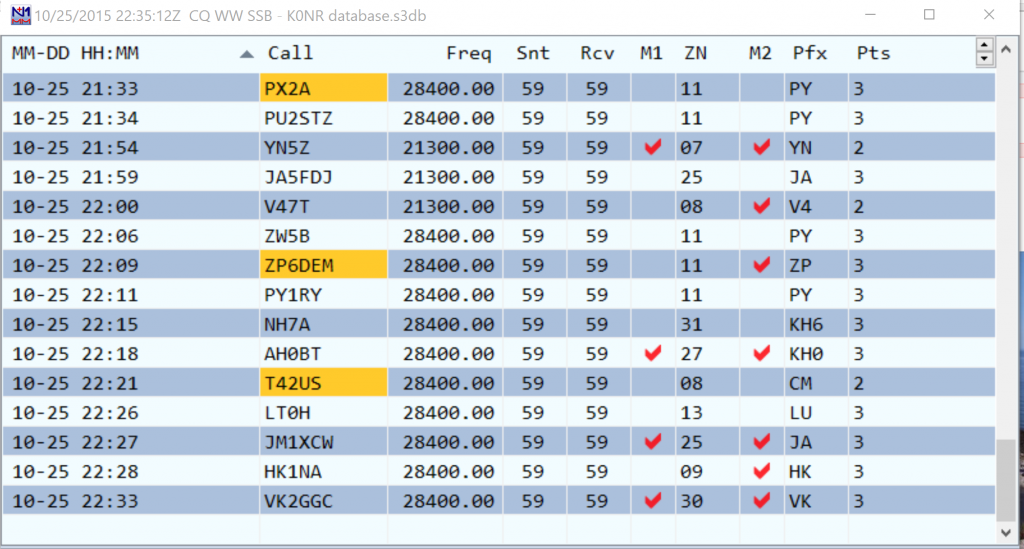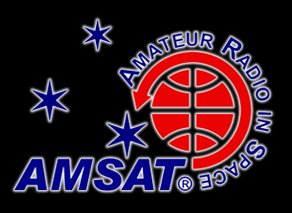Author Archive
 HF Slacker Operation for CQ WW SSB
HF Slacker Operation for CQ WW SSB
The CQ Worldwide DX SSB contest was last weekend and I applied my signature HF Slacker™ operating methodology to this event. Most of the HF gear I have is kept at our cabin in the mountains but I had to be at the house this weekend due to some commitments. I decided to apply Field Day principles and rig up whatever I could with equipment on hand.
 I dug out the Yaesu FT-847 transceiver, an MFJ antenna tuner and a half-size G5RV antenna to configure a basic HF station. Using a fishing pole to cast a steel washer over a tall tree in the back yard, I rigged up the antenna between the tree and the house. The G5RV is a compromise antenna…I’d much rather have something like a trap or fan dipole. But it’s what I had on hand, so I made it work. The impedance presented by this antenna is all over the map, so a decent antenna tuner is a must.
I dug out the Yaesu FT-847 transceiver, an MFJ antenna tuner and a half-size G5RV antenna to configure a basic HF station. Using a fishing pole to cast a steel washer over a tall tree in the back yard, I rigged up the antenna between the tree and the house. The G5RV is a compromise antenna…I’d much rather have something like a trap or fan dipole. But it’s what I had on hand, so I made it work. The impedance presented by this antenna is all over the map, so a decent antenna tuner is a must.
 I started out on 15m with a few contacts to Europe and Central America. Later I moved up to 10m and made even more contacts there. I was mostly searching around for the best DX but still working a few stateside stations. Later in the afternoon, the bands swung towards the west and I managed to work KH7CW and JR3NZC before going QRT for the day.
I started out on 15m with a few contacts to Europe and Central America. Later I moved up to 10m and made even more contacts there. I was mostly searching around for the best DX but still working a few stateside stations. Later in the afternoon, the bands swung towards the west and I managed to work KH7CW and JR3NZC before going QRT for the day.
Sunday morning brought more propagation, first to Europe, then the Caribbean and South America. The high point was working AHØBT in the Mariana Islands and VK2GGC in Australia. AHØBT was not real strong, maybe S5 at my location so I thought I’d struggle to punch through the noise and QRM on the band. However, it only took a couple of calls to make the contact. That’s what I like about the 10m band!
I used the N1MM logging program during the contest. A snapshot of the log is shown below. I only worked the contest intermittently on Saturday and Sunday, maybe 5 or 6 hours total operating time. Still, I managed to work 49 countries and 30 CQ Zones. That’s half way to DXCC on one weekend with a very basic HF station. Radio contests stimulate activity and DX contests bring out the DX. I point this out to encourage others to give it a try, even if they don’t have huge antennas on a tower and a linear amplifier. Almost all of my contacts were on 15m and 10m, which tend to be more productive when conditions cooperate. Twenty meters gets jammed with high power stations so it is often tough going for the little pistols.
I only worked the contest intermittently on Saturday and Sunday, maybe 5 or 6 hours total operating time. Still, I managed to work 49 countries and 30 CQ Zones. That’s half way to DXCC on one weekend with a very basic HF station. Radio contests stimulate activity and DX contests bring out the DX. I point this out to encourage others to give it a try, even if they don’t have huge antennas on a tower and a linear amplifier. Almost all of my contacts were on 15m and 10m, which tend to be more productive when conditions cooperate. Twenty meters gets jammed with high power stations so it is often tough going for the little pistols.
Band QSOs Pts Zone Country 14 2 3 2 2 21 30 70 13 21 28 52 136 15 26 Total 84 209 30 49 Score: 16,511
Another weekend of having fun messing around with radios. Even if I’m an HF Slacker™. 
73, Bob K0NR
The post HF Slacker Operation for CQ WW SSB appeared first on The KØNR Radio Site.
 Digital Voice Balkanization
Digital Voice Balkanization
 Wouldn’t it be cool if we had one digital communications format for the VHF/UHF amateur bands with all equipment manufacturers offering compatible products? The basic modulation and transport protocol would be standard with manufacturers and experimenters able to innovate on top of that basic capability. There would be plenty of room to compete based on special features but all radios would interoperate at a basic level. You know, kind of like analog FM.
Wouldn’t it be cool if we had one digital communications format for the VHF/UHF amateur bands with all equipment manufacturers offering compatible products? The basic modulation and transport protocol would be standard with manufacturers and experimenters able to innovate on top of that basic capability. There would be plenty of room to compete based on special features but all radios would interoperate at a basic level. You know, kind of like analog FM.
Yeah, we don’t have that. 
73, Bob K0NR
Graphic: Adapted from HamRadioSchool.com
The post Digital Voice Balkanization appeared first on The KØNR Radio Site.
 Religion and Ham Radio
Religion and Ham Radio
 We need to get the religion out of ham radio. No, I am not talking about the HF nets that support missionaries or similar activities. (Those people might actually be doing something good for the world.) I am talking about the religious debates concerning new technology…this technology is better than that technology.
We need to get the religion out of ham radio. No, I am not talking about the HF nets that support missionaries or similar activities. (Those people might actually be doing something good for the world.) I am talking about the religious debates concerning new technology…this technology is better than that technology.
Amateur radio is a technical hobby, one based on technology, hobbyist pursuits and mutual interest. One might think that this means issues are looked at objectively and discussions are based on logic, scientific principles and facts. Of course, this is completely wrong. What often shows up in ham radio are religious debates about technology or operating modes.
Here’s a definition of Religion:
a specific fundamental set of beliefs and practices generally agreed upon by a number of persons or sects: the Christian religion; the Buddhist religion.
You can tell when you are stuck in a religious debate…the facts quickly fade and statements like “this is the right way to do it” become louder. Underneath this is a fundamental belief trying to come out that the person may not even be aware they have.
A long running example of a religious debate is Linux versus Windows. On the surface, people argue about which one has more defects, which one is more secure and which one ultimately serves their needs better. Underneath the surface is the religious belief: software should be free, Microsoft is evil, etc. Then there are those Mac enthusiasts (you know who you are)….these folks tend to act like a cult as they attempt to convert other people to their group. (Where is the line between enthusiast and cult member?)
The latest one on the ham radio front is the debate over digital technology in the VHF and higher bands: D-STAR versus DMR (and now Fusion). The debate starts out rational with a discussion of the merits of each but soon the deeply-held beliefs come out: D-STAR is bad because ICOM is pushing it, DMR is good because it is the commercial standard, D-STAR is good because it is an amateur radio standard, D-STAR uses a proprietary vocoder chip so it is bad, etc. Then don’t forget the guys that say “all digital is bad, analog FM is good.”
Again, you can tell when the religion kicks in because the facts start to fade and the beliefs rise to the surface. Usually, these arguments can’t be resolved because you can’t really debate beliefs. What you get instead are flame wars on the various email groups.
What other religious debates are out there? Android versus iOS, Open Source Software versus Commercial Software, My favorite rig versus Your favorite rig, … what else?
-73, Bob K0NR
This post is recycled and updated from a 2007 post. Some things never change.
The post Religion and Ham Radio appeared first on The KØNR Radio Site.
 New Satellite (Fox-1A/ AO-85) is Operational
New Satellite (Fox-1A/ AO-85) is Operational
 Congratulations to AMSAT for the successful launch and initial deployment of the Fox-1A amateur radio satellite.This bird has been designated AO-85 and has an FM transponder on board (435.180 MHz uplink, 145.980 MHz downlink).
Congratulations to AMSAT for the successful launch and initial deployment of the Fox-1A amateur radio satellite.This bird has been designated AO-85 and has an FM transponder on board (435.180 MHz uplink, 145.980 MHz downlink).
I have not heard or worked this satellite yet but early reports indicate that it has a strong signal on the downlink. So start out by trying to hear the bird on 145.980 MHz. To find out when it will be overhead, use the AMSAT pass prediction page or your favorite satellite tracking software.
Download the Special Issue of the AMSAT Journal to get the full story.
73, Bob K0NR
The post New Satellite (Fox-1A/ AO-85) is Operational appeared first on The KØNR Radio Site.
 What’s Wrong With the ARRL?
What’s Wrong With the ARRL?
Every so often a blog posting takes on the topic of “the ARRL needs to change.” A recent one came from Dan KB6NU, referencing some worthwhile ideas he has encountered via Rotary International. (I like Dan’s blog and read it fairly consistently.) Whenever I see this kind of article, my brain immediately thinks:
The ARRL is the worst US national amateur radio organization, except when compared to all others.
Yeah, its easy to criticize the ARRL, but it is the only game in town in terms of a national organization. And they do a lot of good for amateur radio and probably don’t get sufficient credit for that. (I should point out that Dan is very clear that he just wants to see the ARRL improve, especially in attracting new hams. I believe him and I share that motivation.)
It is hard being the ARRL.
Amateur radio is not really one hobby, it is a collection of hobbies and activities. We’ve got CW-enthusiasts, QRP folks, Emcomm volunteers, HF contesters, VHF contesters, tinkerers, 75m AM operators, repeater operators and on and on and on. Because the ARRL is a member-driven organization, it tries to balance these competing interests. Just listen to the random-vector criticism that spews forth: the ARRL is too focused on QRP, doesn’t do enough for QRP, only cares about HF, doesn’t do enough for HF, is against new digital modes, is always promoting new digital modes, thinks CW is the only way to go, gave us the No Code license, hung on to the Morse Code requirement too long. This list goes on and on. It really is impossible to keep everyone happy.
Like every large organization that I belong to, the ARRL is not perfect. But the good it does clearly outweighs the stuff I don’t like, so I enthusiastically support it. Said another way, I get enough benefit out of the membership to justify the dues. The key benefits for me are: QST magazine, Logbook of the World, contests, awards and representation with the FCC. QST is clearly the biggest benefit of membership and many people just view the membership fee as a magazine subscription.
A huge threat to an organization with such a print franchise is the shift from print to new media (video, web, blogs, podcasts, social). The ARRL web site has a lot of good information and most of the bugs have been worked out of the major redesign of a few years ago. They have a basic presence on twitter and podcasts. The ARRL has a youtube channel but the content is weak. At the same time, other people are putting out some good video content. Look at what HamNation, HamRadioNow, HamRadioSchool.com are doing.
The ARRL is a long-lived institution and like most long-lived institutions they tend to be grounded in the past and are a bit old school in nature. Attracting newly licensed radio amateurs, especially Techs, is the big challenge for the ARRL. I don’t know what market research the ARRL does but I suggest they establish on on-going program that gets inside the heads of newer licensees and potential hams to understand how they view the ARRL. This requires an ongoing investment that is coupled to strategy. I’ve seen marketing pros do focus groups, interviews, surveys, etc. that bring customer needs to the surface so an organization can respond to changes that attract new customers members.
If you are an ARRL member, what can you do to change things? Your avenue to make your views known is via your Division Director, so I suggest you reach out to him or her. (Contact information is listed in the front of every QST.) Don’t be surprised if your voice is mixed in with a whole bunch of other people’s views…kind of like Congress 
If you are not a member and spend a substantial amount of time having fun messing around with radios, I encourage you to join the ARRL. You might like it.
That’s my view, what’s yours?
73, Bob K0NR
The post What’s Wrong With the ARRL? appeared first on The KØNR Radio Site.
 You’ve Got Questions, We’ve Got Answers
You’ve Got Questions, We’ve Got Answers
 K3NG has performed an important public service by tabulating the answers to the top ten amateur radio questions swirling about the interwebz. This will save thousands of hours for hams searching for this critical information.
K3NG has performed an important public service by tabulating the answers to the top ten amateur radio questions swirling about the interwebz. This will save thousands of hours for hams searching for this critical information.
Unfortunately, he did not include the questions, so you will have to use your imagination on that. But its not difficult.
73, Bob K0NR
The post You’ve Got Questions, We’ve Got Answers appeared first on The KØNR Radio Site.
 This Spewed Out of the Internet #31
This Spewed Out of the Internet #31
 This is another update on important stuff spewing forth from the interwebz. It has been a while since I’ve done this, so we’ve got some catching up to do.
This is another update on important stuff spewing forth from the interwebz. It has been a while since I’ve done this, so we’ve got some catching up to do.
The KØNR Radio Site has expanded to Facebook. “Like” us there.
There is a statewide email list available to Colorado radio amateurs. Join us there to stay informed about regional events.
Grid locators are important for VHF/UHF operating. I came across this web site that does a good job of mapping the grids. I wrote a Shack Talk article over at HamRadioSchool.com that explains Simplex, Duplex, Offset and Split. Stu WØSTU posted a very helpful article explaing NVIS (Near Vertical Incidence Skywave) Antennas.
In June, Keysight Technologies donated some professional measurement software to the ARRL. Yeah, I had something to do with that.
From the Cheaters Gonna Cheat Department:
- CQ Magazine busts UT5UGR for padding his log in CQ WW contest
- The FCC fines David J. Tolassi, W4BHV, for failing to identify properly
- The FCC also went after Michael Guernsey, KZ8O, with a $22,000 fine. Ouch.
- The FCC also fined Daniel R. Hicks, KB8UYZ, for malicious interference to VHF repeaters.
The Ham Hijinks crew contributed some outstanding literary works to the ham radio community. Recently, they’ve latched onto the theme of hams using cheap radios to not make any contacts on VHF:
- Club Votes: Bob Should Buy New Radio
- No One, Anywhere, Having Good VHF QSOs
- Optimistic 6m DXer Ready for Opening of the Year
- New Ham Unsure If He Really Needs to Stand When Told To Stand By
Dodge uses Morse Code in one of their car commercials. Speaking of cars, check out Wired’s article: Hackers Remotely Kill a Jeep on the Highway.
Steve WGØAT created another SOTA video, this one with Clay NF1R on Mount Herman.
I heard this song by Phil Collins on a the radio recently and I’m convinced its about the heartbreak of trying to work a rare DXpedition. Give a listen.
And then there’s this…a very well done video about ham radio that has lots of people talking.
Well, that’s all for now.
73, Bob K0NR
The post This Spewed Out of the Internet #31 appeared first on The KØNR Radio Site.












